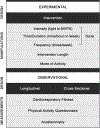Aerobic exercise, cardiorespiratory fitness, and the human hippocampus
- PMID: 34101305
- PMCID: PMC8295234
- DOI: 10.1002/hipo.23337
Aerobic exercise, cardiorespiratory fitness, and the human hippocampus
Abstract
The hippocampus is particularly susceptible to neurodegeneration. Physical activity, specifically increasing cardiorespiratory fitness via aerobic exercise, shows promise as a potential method for mitigating hippocampal decline in humans. Numerous studies have now investigated associations between the structure and function of the hippocampus and engagement in physical activity. Still, there remains continued debate and confusion about the relationship between physical activity and the human hippocampus. In this review, we describe the current state of the physical activity and exercise literature as it pertains to the structure and function of the human hippocampus, focusing on four magnetic resonance imaging measures: volume, diffusion tensor imaging, resting-state functional connectivity, and perfusion. We conclude that, despite significant heterogeneity in study methods, populations of interest, and scope, there are consistent positive findings, suggesting a promising role for physical activity in promoting hippocampal structure and function throughout the lifespan.
Keywords: cardiorespiratory fitness; exercise; magnetic resonance imaging; perfusion; white matter.
© 2021 Wiley Periodicals LLC.
Conflict of interest statement
The authors declare no conflict of interest.
Figures



References
-
- 2018 Physical Activity Guidelines Advisory Committee. (2018). 2018 Physical Activity Guidelines Advisory Committee Scientific Report. U.S. Department of Health and Human Services.
-
- Aggleton JP, Neave N, Nagle S, & Sahgal A (1995). A comparison of the effects of medial prefrontal, cingulate cortex, and cingulum bundle lesions on tests of spatial memory: Evidence of a double dissociation between frontal and cingulum bundle contributions. Journal of Neuroscience, 15(11), 7270–7281. - PMC - PubMed
Publication types
MeSH terms
Grants and funding
LinkOut - more resources
Full Text Sources

